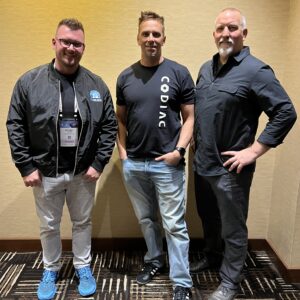|
|
 Michael Levan, Ben Ghazi, and Mark Freydl presented for Codiac at AppDev Field Day 2 |
This Introduction date is November 13, 2024 at 12:00-12:40.
Presenter: Ben Ghazi, Mark Freydl, Michael Levan
Value-Driven Engineering for Everyone with Codiac
Watch on YouTube
Watch on Vimeo
Mark Freydl, CEO and Co-Founder, introduces Codiac, a platform designed to streamline the build and release process for SREs and development teams by addressing the friction and complexity that often arise in modern DevOps workflows. The platform focuses on simplifying the communication and coordination between different team members involved in the software development lifecycle (SDLC). By providing a common language and intuitive interface, Codiac aims to reduce the manual overhead and miscommunication that can occur when managing infrastructure and deployments. The platform offers both a CLI and GUI, allowing users to interact with it in various ways, whether through a browser, console, or pipeline, ensuring that all team members, from developers to project managers, can understand and contribute to the process.
One of the key features of Codiac is its “build once, configure on deploy” approach, which allows teams to build a container once and then configure it dynamically as it moves through different environments, such as development, QA, and production. This eliminates the need for manual configuration changes and reduces the risk of errors during deployment. The platform also supports snapshot deployments, where multiple services can be deployed together as a collective version, ensuring consistency across environments. Additionally, Codiac automates tasks like ingress management and environment scaling, further reducing the burden on SREs and allowing them to focus on higher-level discussions around performance and utilization rather than getting bogged down in the minutiae of YAML files and configuration management.
The motivation behind Codiac stems from the founders’ frustration with the growing complexity of modern infrastructure and the inefficiencies it creates for development teams. They recognized that while tools like Kubernetes offer powerful capabilities, they also introduce significant overhead, making it difficult for teams to move quickly and efficiently. By abstracting away much of the complexity and providing a more user-friendly interface, Codiac enables teams to focus on delivering value to the business rather than getting stuck in the technical weeds. The platform is designed to be extensible and adaptable to different workflows, making it a valuable tool for organizations looking to improve their DevOps processes and reduce the friction that often accompanies large-scale software development.
Personnel: Mark Freydl
Demonstrating the Codiac Value-Driven Engineering Platform
Watch on YouTube
Watch on Vimeo
Michael Levan demonstrated the Codiac Value-Driven Engineering Platform, focusing on simplifying the deployment and management of applications across Kubernetes clusters. Levan emphasized the challenges developers face when dealing with infrastructure and configuration management, particularly the repetitive nature of writing YAML or Infrastructure as Code (IAC) configurations. He highlighted how Codiac addresses these pain points by allowing users to deploy applications without worrying about the underlying infrastructure. Through a drag-and-drop interface, users can deploy containerized applications, such as a Go web app, without needing to manually manage Kubernetes manifests or other complex configurations. The platform abstracts much of the infrastructure management, making it easier for developers to focus on their applications rather than the environment they are running in.
Levan also demonstrated how Codiac allows for dynamic configuration management across different environments, such as development, staging, and production. Users can easily adjust parameters like replica counts for different environments without needing to maintain multiple Kubernetes manifests or use tools like Helm or Kustomize. The platform provides a central configuration system that can be modified per environment or per “cabinet,” which Levan likened to a Linux namespace or a mini-environment. This flexibility allows for more efficient application management, as users can make changes to configurations and redeploy applications either through the graphical interface or via the command line interface.
Additionally, Levan introduced the concept of “snapshots” within Codiac, which allows users to capture the state of their application stacks and easily redeploy them across different environments or clusters. This feature is particularly useful for scenarios like blue-green or canary deployments, where different versions of an application need to be tested or rolled out incrementally. The platform also supports cluster migrations, enabling users to move applications between clusters with minimal effort. Codiac abstracts much of the complexity of managing Kubernetes clusters, allowing developers to treat clusters as ephemeral resources that can be easily replaced or upgraded without manual intervention. Overall, the platform aims to streamline the deployment process, reduce the need for manual configuration, and provide a more efficient way to manage applications across multiple environments.
Personnel: Michael Levan








